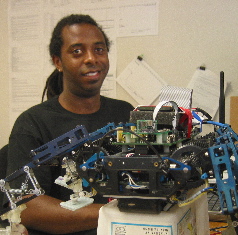new web: http://bdml.stanford.edu/pmwiki
TWiki > Rise Web>TWikiUsers>AMcClung (01 Nov 2006, AMcClung? )
Rise Web>TWikiUsers>AMcClung (01 Nov 2006, AMcClung? )
Arthur J. McClung, III - "Trey"
|

|
UPDATED (09/08/05)
Projects:
- Robot Information Distribution and Maintenance
- Working with lab members to get familiar with using robot (along with documentation)
- Debug/resolve any robot platform issues
- Manuevers - related to climbing
- Consider maneuvers while climbing
- Test iSprawl maneuverability (SysID related to limits for 'dynamic' maneuvers)
- Compare and contrast differences between Sprawlettes and iSprawl
- Testing
- Use LSAN for accelerometer and strain gage data
- Due to force plate size, multiple legs can touch at same time
- DONE-Need to syncronize video and force data to decifer data
- May want to reduce surface area of force plate
- Develop climbing metrics to determine "good" climbing from force data
- Develop vertical maneuvering metrics to determine "good" maneuvers
Planning:
| Task | Approx Dur | Start | Stop | Notes |
|---|---|---|---|---|
| Full platform tests | 2-4wks | ??/??/?? | ??/??/?? | Testing new trajectories/gaits, feet, designs on full platform |
| Manuevers investigation | 3-4wks | ??/??/?? | ??/??/?? | System identification of maneuvers on iSprawl Solidify methodology to characterize noisy systems with SysID techniques |
| Metrcs for Climbing | 2-4wks | ??/??/?? | ??/??/?? | Work on developing metrics to evaluate climing performance |
A basic testing environment needs to be established for tests on the Stanford force plate. Due to the size of the current force plate, multiple legs can touch the force plate at the same time. To help decipher what is going on, video data can be used along with video data, but these two sources need to be syncronized. I have developed some code to syncronize video (AVI) and force data for our setup. Also, we may consider resizing the force plate to reduce force contamination by other legs. Performance metrics for climbing and maneuverability should be developed to determine the effectiveness of feet, trajectories, ankles, etc. Currently, the 1)LSANs, 2)potentiometers, and 3)force sesning ankles are becoming available and will help to determine the climbing performance of the various gaits and feet that are developed. The new sensor feedback will greatly aid development on many fronts. Manuevers
These tests and investigations will expand on the manuevering work that I has previously done for the Sprawl robots. This is an extension to vertical and inclined surfaces.
Project Links:
PracticeDemo05Notes - Notes from SwRI by me and Miguel TreysTestTrackNotes - Notes and links related to test track StanfordTestTrack - Links to test track related items (status, testing procedures, descriptions, etc) StanfordTestTrackSummer04Tests - Links to summer tests (friction, foot designs, trajectory) SyncronizeVideoAndData - MATLAB software to syncronize video and data RiSERelatedParts? - (Private) A listing of useful parts and vendorsOther:
TreysQNXNotes - General notes on dealing w/QNX for RiSE project TreysRandomSoftware - a partial list of useful software (mostly Matlab) I've accumulated TreysDynamicClimbingNotes - General notes/links on dynamic climbing HumanClimbing - Notes from research on human climbing for Moto's McGill trip TreysLinks - On-going list of interesting internet links TreysRHexStackNotes - Notes from my CMU visit 01/22/04-01/23/04 FootAndLegTrajectoryTestingProcedure - Notes on foot/leg testing with the RHex stack VideoCompression - Notes on how to get compression working well with the Mac TreysOSNotes - General notes on installing multiple OS on a machine TreysLatexNotes - Notes on Latex that I've found useful TreysPics - Page to keep track of some of my research picturesRecent Projects:
- ASME IMECE '04 paper presentation at Anaheim, CA
- Climbing Wall Testing - Summer testing for the climbing wall
- Friction tests - determine the friction coef. (
 ) between various foot and wall materials
) between various foot and wall materials
- Foot & leg tests - determine appropriate foot designs and configurations
- Trajectory tests - determine trajectory keys that allow for climbing
- Adhesion tests - determine the adhesive properties of several feet
- Friction tests - determine the friction coef. (
The testing performed on the Stanford test track will help to identify proper design choices for the foot and leg, characterize the friction and adhesive forces available in various situations and explore the key characteristics of the trajectory that lead to climbing.
Friction tests
The friction tests are intended to identify the friction between various foot materials and surface materials.
Possible foot materials: Urethanes, Pressure Sensitive Adhesives, Dry Adhesives
Possible wall materials: Penetrable, Non-penetrable(rough), Non-penetrable(smooth)
Foot & leg tests
The foot & leg testing will examine the effectiveness of several of the Stanford and BDI designs.
Specimens: SangBae #1 (old Sprawlita leg w/ claws), SangBae #2 (sprung toes), Block foot (spines and lamellae), Dactyl (configurable spines)
Trajectory tests
The trajectory tests will work to determine the crucial stages within the trajectory and the important actions required. The areas of focus will be: attachment, detachment, stroke, swing
Adhesion tests
The adhesion tests will be used to guage the effectiveness of various adhesion strategies. These strageties may include spines, dry adhesives, et al. Personal Preferences (details in TWikiVariables)
- Horizontal size of text edit box:
- Set EDITBOXWIDTH = 70
- Vertical size of text edit box:
- Set EDITBOXHEIGHT = 26
- Style of text edit box.
width: 99%for full window width (default),width: autoto disable.- Set EDITBOXSTYLE = width: 99%
- Optionally write protect your home page: (set it to your WikiName)
- Set ALLOWTOPICCHANGE =
- TWikiPreferences has site-level preferences of TWiki .
- WebPreferences has preferences of the TWiki .Rise web.
- TWikiUsers has a list of other TWiki users.
PrivateRiSE?
 Useful stuff:
Useful stuff:To install/remove programs from non-admin login (Windows)
-
runas /profile /user:administrator "control appwiz.cpl"
- Download here: McClungRefs.enl
< pre > text with "<" or ">" < /pre >) to appear with < and >, use < and >
Ideas, requests, problems regarding TWiki? Send feedback